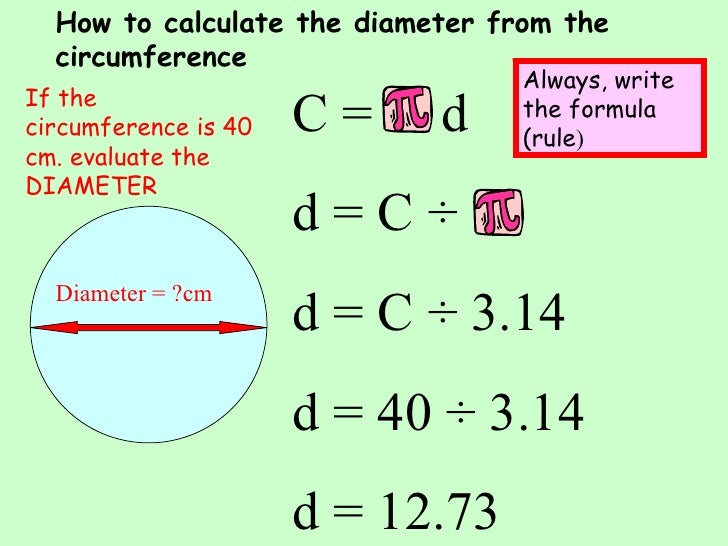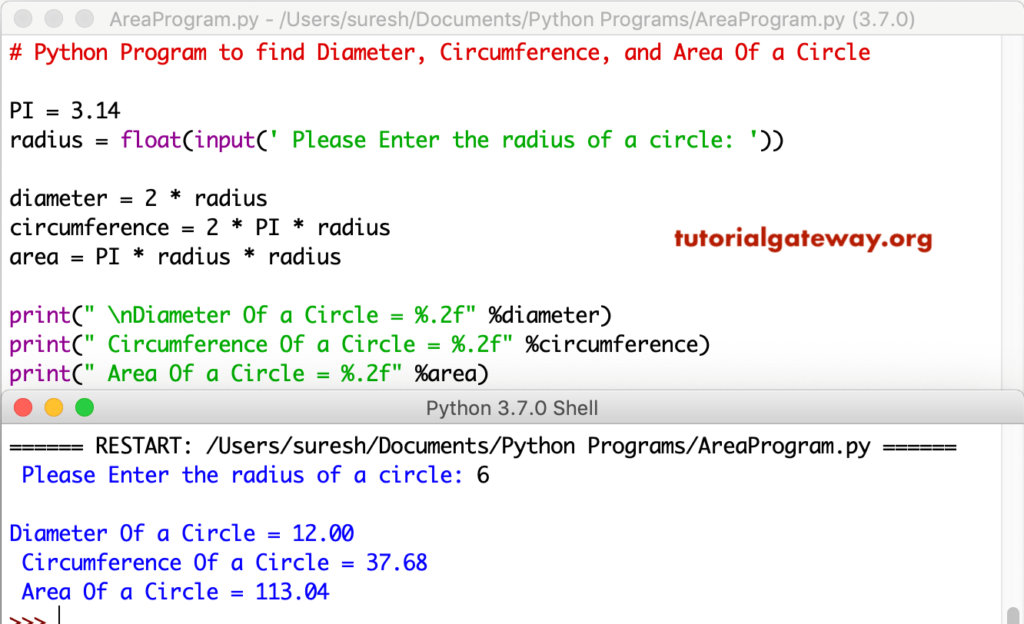Let's jump to number one on our area of a semicircle worksheet. In this case we are given the distance from the middle of the circle to the outer edge which is known as the radius. We know that the radius is equal to 6 inches because it's given to us in order to solve using the formula. We're going to take our radius which is 6 inches and substitute it in for r into the formula.
We take area equals pi times the radius which in this case is 6 squared and then divided by 2. First thing we do according to order of operations is 6 squared so 6 times 6 which is 36 and then we're going to divide by 2. The Area of a Semicircle is all of the area that is inside of a semicircle.
The way you find the Area of a Semicircle is similar to how you find the area of a circle. Usually you find the area of a semicircle using radius but sometimes you will have to find the Area of a Semicircle with diameter. The diameter is twice as long as the radius, or the radius is half of the diameter.
The formula for how to find Area of a Semicircle is area equals pi times the radius squared then divided by two. If you have the area of a semicircle with diameter that means that you have to divide the diameter by two to get the radius. Once you have the radius you can use the Area of a Circle formula.
When simplifying you need to do follow the order of operations. You must square the radius and then multiply it times pi and then finally divide by two. The next problem on our area of a semi-circle worksheet we're going to talk about how to find the area of a semi-circle with diameter. We know that the area of a semi-circle is pi times the radius squared and then divided by 2. To get the radius all you do is you take the diameter divide by 2.
So 3 divided by 2 is 1.5 feet so now we know the radius is 1.5 and then you follow the same procedure that you did in the previous problem. You take the radius which is 1.5 and you substitute it in where r used to be. Area is equal to pi times the radius which is 1.5 squared and then you're going to divide it by 2. You do 1.5 times 1.5 which is 2.25 then you're going to do pi times 2.25 and that will give you 7.07 divided by 2 and your final answer will be 3.53 feet squared. The only extra step in finding the area of a circle with the diameter is having to divide the diameter by 2 to get the radius. The Area of a Semicircle is the area that is within a semicircle.
Typically you discover the area of a semicircle by utilizing the radius of the semicircle, however you can discover the Area of a Semicircle with diameter. The diameter is twice the length of the radius, in other words, the radius is half of the diameter. The equation for how to discover Area of a Semicircle is pi times the radius squared divided by two equals the area. In the event that you have to find the Area of a Semicircle with diameter you have to divide the diameter by two. Then you can utilize the Area of a Semicircle equation.
The perimeter and area of triangles, quadrilaterals , circles, arcs, sectors and composite shapes can all be calculated using relevant formulae. Now that you know how to calculate the circumference and area of a circle, you can use this knowledge to find the perimeter and area of composite figures. The trick to figuring out these types of problems is to identify shapes within the composite figure, calculate their individual dimensions, and then add them together. Πr² is the formula for finding the area of a circle. To find the area of a semicircle just divide the answer by two.
So take the radius, square it, which in this case would be 100, multiply it by π [pi (3.14)] and divide it by two. Term Definition Area Area is the space within the perimeter of a two-dimensional figure. Circle A circle is the set of all points at a specific distance from a given point in two dimensions. Diameter Diameter is the measure of the distance across the center of a circle. The diameter is equal to twice the measure of the radius. Since area is a measure of two dimensions, you always report area in square units like square inches or square feet .
For those having difficulty using formulas manually to find the area, circumference, radius and diameter of a circle, this circle calculator is just for you. The equations will be given below so you can see how the calculator obtains the values, but all you have to do is input the basic information. If the area of the circle is not equal to that of the triangle, then it must be either greater or less. We eliminate each of these by contradiction, leaving equality as the only possibility. We use regular polygons in the same way. Pi (π) is a non-algebraic number that represents the ratio of the distance around the circle to its diameter, usually estimated as 3.14.
To solve for area, square the radius then multiply by 3.14. Lauren is planning her trip to London, and she wants to take a ride on the famous ferris wheel called the London Eye. While researching facts about the giant ferris wheel, she learns that the radius of the circle measures approximately 68 meters. What is the approximate circumference of the ferris wheel? Use 3.14 as an approximation for pi.
We know that the radius of a quarter circle is the same as the radius of the whole circle. That is, it is equal to the radius r that was used in the formula for the circumference. The area of a regular polygon is half its perimeter times the apothem. As the number of sides of the regular polygon increases, the polygon tends to a circle, and the apothem tends to the radius.
This suggests that the area of a disk is half the circumference of its bounding circle times the radius. The first step for calculating the area of a circle from its diameter is to find that diameter. While math problems often list this value, in the real world, you must find the diameter yourself. The diameter is the length of a line that begins at the edge of the circle, passes through the center of the circle, and ends at the opposite edge of the circle. To measure, you will need a ruler for small circles or a tape measure for large circles. In the below figure, the line AC is called the diameter of the circle.
The diameter divides the circle into two halves such that they are equal in area. These two halves are referred to as the semicircles. The area of a semicircle is half of the area of a circle. The distance around a rectangle or a square is as you might remember called the perimeter.
How To Find The Area Of A Half Circle The distance around a circle on the other hand is called the circumference . It looks like you calculated the area of a circle using a radius of 2; in this figure, the radius of each circle is 1. To find the area of the figure, imagine the two semi-circles are put together to create one circle.
Then calculate the area of the circle and add it to the area of the square. Find the total perimeter by adding the circumference of the semicircle and the lengths of the two legs. Since our measurement of the semi-circle's circumference is approximate, the perimeter will be an approximation also. The first step is to identify simpler figures within this composite figure. You can break it down into a rectangle and a semicircle, as shown below. In either case, the cross-section is the same all the way through, like the cylinder.
The volume of the prism is the area of the base times the height. So to calculate height, divide the volume of a prism by its base area. Here, we have discussed the programs to find the area and perimeter of semicircle in C, C++, Java, C#, PHP, python, and JavaScript. Hope you find the article helpful and informative. This tutorial gives you the semicircle radius formula and explains how to calculate the radius of the semicircle given the circumference or the diameter.
We have seen that by partitioning the disk into an infinite number of pieces we can reassemble the pieces into a rectangle. This is called Tarski's circle-squaring problem. The nature of Laczkovich's proof is such that it proves the existence of such a partition but does not exhibit any particular partition. A circle is one of the most widely recognizable geometric shapes, but exploring the mathematical concepts of diameter and area can sometimes feel tricky. An inscribed angle is usually formed in a circle with the help of two chords that tend to have a common endpoint on that circle. The measure of this type of an angle is always half the measure of the intercepted arc.
And according to the Inscribed Angle Theorem, an angle inscribed within a semicircle tends to be 90°, i.e., it's a right angle. This is due to the fact that the intercepted arc tends to measure 180°. So, naturally, any angle that is corresponding to it and is inscribed within, would measure half of it, which makes it a right angle. The angle inscribed in a semicircle is always 90°. The inscribed angle is formed by drawing a line from each end of the diameter to any point on the semicircle. It doesn't matter which point on the length of the arc, the angle created where your two lines meet the arc will always be 90°.
Now to practice, try drawing a circle on a piece of paper, and measure your diameter with a ruler. Then, find your radius, and circumference. Measure the Radius The next step is to measure or calculate the radius. For this example, we are going to assume the diameter of the semi-circle is given at 2 meters . To find the radius we must divide the diameter by 2.
This yields a result of 1 meter for the radius. The diameter of any circle is two times the length of that circle's radius. A circle is a two-dimensional figure just like polygons and quadrilaterals. However, circles are measured differently than these other shapes—you even have to use some different terms to describe them. Let's take a look at this interesting shape. When a line passes through the center and touches the two ends of the circle, then a semicircle is formed.
The diameter of a circle divides it into two halves that are referred to as semicircles. A semicircle is the half part of a circle. In this article, we will discuss the program to find the area and perimeter of semicircle in different programming languages. Here you will find a range of free printable area sheets and support, which will help your child to learn to work out the area of different semi circles. The circles radius is simply half the diameter of the circle.
Therefore, the radius of the semicircle is equal to the radius of the circle. The triangle has a base of 5.5 inches and a height of 4 inches. The diameter of the circle matches the base of the triangle. The triangle has a base of 7 inches and a height of 6 inches. The triangle has a base of 5 inches and a height of 4 inches.
Next, recognize that you have been given a diameter and need to divide that by 2 to get the radius. The problem states that the diameter of the circle is the same as the width of the rectangle, 3 feet. For, a perpendicular to the midpoint of each polygon side is a radius, of length r. And since the total side length is greater than the circumference, the polygon consists of n identical triangles with total area greater than T. Again we have a contradiction, so our supposition that C might be less than T must be wrong as well. Suppose that the area enclosed by the circle is less than the area T of the triangle.
Circumscribe a square, so that the midpoint of each edge lies on the circle. The area of the polygon, Pn, must be less than T. In mathematics, a semicircle is a one-dimensional locus of points that forms half of a circle.
The area of a semicircle is half the area of the circle from which it is made. Any diameter of a circle cuts it into two equal semicircles. There is an actual sculpture based on the mechanism/concept of an arbelos in Kaatsheuvel, in the Netherlands. The two endpoints of the semicircle's diameter and the inscribed angle will always form a right triangle inside the semicircle. The perimeter of a semicircle is half the original circle's circumference, C, plus the diameter, d.
Since the semicircle includes a straight side, its diameter, we cannot describe the distance around the shape as the circumference of a semicircle; it is a perimeter. To find the area of a semicircle with diameter, divide the diameter by 2 to find the radius, and then apply the area of a semicircle formula. The area of a semicircle is always expressed in square units, based on the units used for the radius of a circle. The area of a semicircle is the space contained by the circle. The area is the number of square units enclosed by the sides of the shape.
Now, let's take the circle with the diameter of 9 cm, and radius of 4.5 cm, and calculate the circumference. Now, you may be asking, "Well where did pi come from, and why do we all the sudden get the circumference if we multiply said pi by our diameter? " If you are not asking that question… You should, and I'm going to answer it anyways. Circumference is comparable to the perimeter of a shape, like a parallelogram. If you were to cut the line of a circle, as if it were a string, and lay it out to measure. This length would be equivalent to the circumference.
However, since a circle has a continuous curve, we use the word circumference rather than perimeter to distinguish it. Calculate the Area The final step is the plug all of the information into the formula or simply use the calculator. Using the formula we find the area of this semi-circle is 1.570 meters squared. Use the this circle area calculator below to find the area of a circle given its diameter, or other parameters.
To calculate the area, you just need to enter a positive numeric value in one of the 3 fields of the calculator. You can also see at the bottom of the calculator, the step-by-step solution. It looks like you calculated the area of the square, but not the circle. Imagine the two semi-circles are put together to create one circle. Identify smaller shapes within the composite figure.





















































